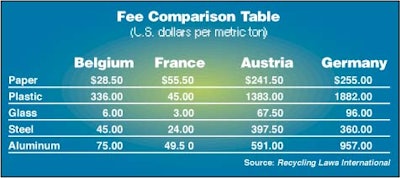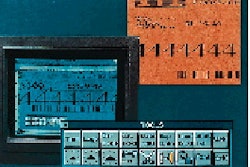A Directive on Packaging & Packaging Waste passed in December 1994 to "harmonize" the European Union's 15 members' individual laws. Today, however, each country is going in its own direction, causing major confusion for those who design packaging. While distributors handle most of the fees and paperwork, North American packagers may find some of their designs will cost dearly to market in Europe-the regulations can turn design and lifecycle priorities upside down. Companies that market worldwide are finding that Western Europe is just the beginning. Eastern Europe is already looking to tax and regulate packaging, while several Asian countries are implementing their own versions of "producer responsibility." The European Directive requires that by July 2001, countries recover a minimum of 50% of their used packaging (i.e. recycle, compost or waste-to-energy, etc.); the total material recycling rate must be 25%, with no material recycled at less than 15%. Member states recovering more than 65% or recycling more than 45% must demonstrate they have enough capacity to handle the material. Exceptions: Greece, Ireland and Portugal have until the end of 2005 to meet these targets and will only be held to 25% recovery of used packaging by July 2001. While the Directive's intent was to "harmonize" national measures on package recycling, about the only thing constant are the set of goals, and eventually the required symbols, on the packages. Each country can set up its own "economic instruments" (read: taxes, deposits, or a combination), and each country can stress different types of packaging from different sources. There will often be separate systems for sales and transport packaging complicating the patchwork. All packaging affected The Directive applies to all packaging-there are no specific exemptions for institutional, commercial or other packaging difficult to recycle. Every company supplying companies within the European Union with raw materials for packaging, finished packaging, packaging components or packaged goods will be affected by the Directive, as will distributors of packaged goods and companies involved in the collection, sorting, recovery or disposal of packaging waste. The Directive also covers disposable cups, plates and cutlery used in the foodservice sector, but does not include the large road, rail, ship and air containers. The European Commis-sion and a committee of government experts from the member states (the "Article 21 Committee") will be deciding what to do about any problems in applying the Directive. In particular, primary packaging for medical devices and pharmaceutical products, small packaging and luxury packaging will be examined. Meanwhile, medical packaging is covered by the Directive until the committee decides on exemptions. This is not an exclusive list, and it is open to industry to propose other exemptions. The Directive is binding on national governments, not on individual companies. Companies will simply be responsible for complying with whatever legal requirements are laid down at the national level. Marking a quagmire The European Union is supposed to agree on a marking and identification system by January 1997. While a Commission decision on material identification was agreed to, it was held up for legal reasons in early 1996. The Council of Ministers and the European Parliament are responsible for a Directive on the Marking of Packaging which will go through the full law-making process. This prescribes symbols indicating reusability and recyclability. The draft proposal for a round circle of arrows was held up in May 1996 by high level EC officials apparently responding to protests from industry. The draft would have banned all other symbols, including the popular "Mobius loop" or chasing arrows. Germany and Green Dot Many of the individual symbols used in various countries are presented with this report. Germany enacted the world's most stringent-and best-known-packaging ordinance in 1991. It forced a direct take-back obligation on the entire "packaging chain": manufacturers and distributors, including wholesalers. If the 80% collection and re-processing quota is not met (set from July 1995), then retailers would have to take back directly, and there would be deposits on a wide range of items. Industry formed the Duales System Deutschland (DSD) to handle sales packaging on direct take-back. Since the ordinance allowed industry little time to gear up for 40 million households, deals were cut too quickly, and DSD ended up in debt to the haulers. The system costs industry about $3 billion per year. All sales packaging must have a "guarantee," and high "Green Dot" fees must be paid by brand-owners or importers to cover the costs of collection and sorting (plastics "Green Dot" fees also must cover reprocessing, adding about 90¢ per pound). Distributors must in addition take direct responsibility for transport packaging. Usually, the distributor picks up the tab for whatever arrangements are made by the end user. He can deduct the "going rate" from invoices to cover recycling fees. Other choices? Germany's rigid system does not allow for incineration of the DSD material, although most of the plastics are now going to be used as a replacement for coke in the steel making process (typically, waste-to-energy is not considered "recycling" in the U.S.). For a while, Germany tried to dump excess materials collected on neighboring countries, but that wreaked havoc on various recycling markets in Europe, and even affected policy making in China. The Ministry of the Environ-ment is now trying to amend the ordinance to soften it somewhat. But state governments (called "Lo/oonder") want bans and more stringent laws, so there has been a deadlock. The European Commission has filed a complaint against Germany on its 72% refillables quota for beverages, because it tends to shut out imports. Currently there are rumors that the government might ease up on applying its refillables quota on foreign companies, though observers say this won't fly politically. No other country has precisely copied Germany's strict "manufacturer's responsibility" law, though a few have come close, (Austria, and perhaps Belgium and later Spain). The "Green Dot" symbol, which means a company has paid its DSD license fees, has become well-known in Europe. DSD has licensed its symbol to Austrian, French and Belgian organizations, and a number of other countries are interested. The confusing issue for ex-porters is that use of the symbol on the pack signifies payment of appropriate fees in each country where required, but there is no pan-European program. Some countries, such as the Netherlands, do not want to use it. Using the symbol without payment of fees can bring lawsuits for fraud. Many countries will move in the direction of "shared responsibility" rather than full "manufacturer's responsibility," as in Germany. For example, in France, manufacturers did not have to set up their own curbside collection system. Government continues to handle the residential collection end. France has a goal to "valorize" (recover) 75% of packaging waste, but it is taking it slow, allowing for pilot programs. Manufacturers still have to either join a third-party organization such as Eco-Emballages, or take back directly or set up a deposit system. There is a separate decree for transport packaging, which places an obligation on end-users. Implementation slow Technically, few countries "met" the July '96 deadline from the European Union for implementing law under the Directive. Some examples: Austria has stringent recycling targets on beverage containers and limits on disposal of other packaging. Its main recovery organization handles sales and transport packaging. The law must be amended again because of various legal challenges. Belgium never implemented its original eco-tax on packaging, but amended the law in March 1996. Nonrefillable containers are taxed (BF15 per container) if they do not meet certain recycling targets. In addition, there is now an interregional cooperation agreement that specifies recycling targets that start at 35% in 1996, going up to 50% by 1999; "valorization" targets go up to 80% (which means total recovery through all means, including incineration). The new agreement places strict requirements on third-party organizations, retailers and manufacturers. Both Portugal and Luxembourg have come under fire for including refillables quotas in their new or proposed packaging laws. The Luxembourg bill would place a hefty eco-tax on non-refillable containers unless certain refillables quotas and recycling targets were met. The EC took a hard line against Luxembourg's proposal that resulted in it being recently withdrawn. In the United Kingdom, the government has published draft regulations on the new packaging take-back law, which places obligations on all parts of the packaging chain based on a complex formula. Each link in the packaging chain can join a third-party organization, or collect by itself. This they can do by delivering collected waste directly to a reprocessor and obtaining a certificate, or buying a certificate from a hauler or local authority, or from another packaging company that has more certificates than it needs. For imported packaging, the importer must take responsibility for any operations that took place outside the U.K. Norway and Switzerland are not part of the EU, but they have adopted producer responsibility laws for packaging anyway. Switzerland sets maximum tonnages of packaging allowed in waste. Referring to new amended proposals from Belgium, Germany and Spain, British consultant David Perchard observes: "Countries where regional governments have a large degree of autonomy are tending to produce more restrictive packaging legislation than unitary states, since each regional authority can insist on its own 'wish list' being included." He advises companies to watch development of the third-party organizations carefully, probably best done through their overseas distributors. The efficiency of a collecting organization will affect the size of the fees imposed on packagers. Some medical and other packaging that may be difficult to recycle could be up for exemption, but Perchard believes exemptions can be a double-edged sword. Member states are still free to regulate such packaging, but without the "free trade" protections that the Directive affords to the packaging it covers. In general, the existing take-back laws have favored single-material sales packaging; fewer blister packs; less secondary packaging; lighter packs; use of paper for dunnage and corrugated paper pallets. Observers say that overall, EC policy is moving in the direction of higher road and fuel taxes. That's why lighter packaging will be necessary as transport gets ever more expensive. c Michele Raymond is publisher of State Recycling Laws Update and Recycling Laws International, based in Riverdale, MD. Phone: 301/345-4237; e-mail: [email protected]; Internet: www.raymond.com/recycle.





























